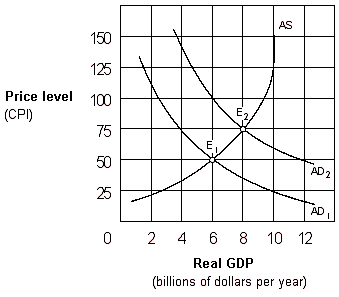A) inverse
B) independent
C) direct
D) linear
Correct Answer

verified
Correct Answer
verified
Multiple Choice
In the aggregate demand/aggregate supply model, a country's full-employment real GDP is represented by:
A) prices.
B) aggregate demand.
C) aggregate supply.
D) an increase in the general level of prices.
Correct Answer

verified
Correct Answer
verified
Multiple Choice
In the United States during the 1960s, government spending dramatically increased to fight the Vietnam War, which resulted in:
A) demand-pull inflation.
B) cost-push inflation.
C) a disinflationary recession.
D) stagflation.
Correct Answer

verified
Correct Answer
verified
Multiple Choice
The vertical portion of the aggregate supply curve shows that at full employment an increase in the price level will:
A) not alter the economy's full-employment real GDP.
B) increase the economy's full-employment real GDP.
C) reduce the quantity of goods and services purchasers will demand.
D) improve the overall efficiency of resource use.
Correct Answer

verified
Correct Answer
verified
Multiple Choice
For an economy, aggregate demand equals:
A) consumption plus investment plus government spending plus exports.
B) consumption plus investment plus government spending plus (exports minus imports) .
C) consumption plus investment plus (taxes minus transfers) plus (exports minus imports) .
D) consumption plus investment plus government spending plus net exports (imports minus exports) .
Correct Answer

verified
Correct Answer
verified
Multiple Choice
Which of the following reasons helps explain why the aggregate demand curve is downward sloping?
A) The real balances effect or wealth effect: Consumers spend more on goods and services when the price level falls because lower prices increase consumer purchasing power.
B) The producer-push effect: At less than full employment, increases in quantity demanded will raise price, and thus will motivate sellers to produce more.
C) The hidden inflation effect: As the price level rises, consumers fail to recognize that prices are higher, and consequently they fail to reduce expenditures on goods and services.
D) The cost-pull effect: As costs of production rise, consumers are pulled to buy more of the products they want most.
Correct Answer

verified
Correct Answer
verified
Multiple Choice
Using the AD-AS model, if consumers and business become more optimistic about the future direction of the economy and increase spending, then:
A) aggregate demand will decrease.
B) aggregate demand will increase.
C) long-run aggregate supply will increase.
D) long-run aggregate supply will decrease.
Correct Answer

verified
Correct Answer
verified
Multiple Choice
In the intermediate range of the aggregate supply curve, higher aggregate demand will increase:
A) both the price level and real GDP.
B) real GDP without raising the price level.
C) the price level without affecting real GDP.
D) the price level but reduce real GDP.
Correct Answer

verified
Correct Answer
verified
Multiple Choice
Exhibit 10-4 Aggregate supply and demand curves
 The increase in the price level as the economy moves from E1 to E2 in Exhibit 10-4 represents:
The increase in the price level as the economy moves from E1 to E2 in Exhibit 10-4 represents:
A) cost-push inflation.
B) demand-shock inflation.
C) wage push inflation.
D) demand-pull inflation.
Correct Answer

verified
Correct Answer
verified
Multiple Choice
The real balance effect (wealth effect) , the interest rate effect, and the net exports effect all help to explain the:
A) decrease in supply in the loanable funds market.
B) large federal budget deficit.
C) increase in short-run aggregate supply.
D) downward-sloping aggregate demand curve.
Correct Answer

verified
Correct Answer
verified
Multiple Choice
According to the interest rate effect, as the price level rises,:
A) people feel poorer and buy less.
B) United States products become more expensive and foreigners buy less U.S. goods.
C) interest rates fall, and people buy less.
D) interest rates rise, and people buy less.
Correct Answer

verified
Correct Answer
verified
Multiple Choice
Given aggregate demand, a decrease in aggregate supply creates:
A) a higher price level and a higher GDP level.
B) a lower price level and a higher GDP level.
C) cost-push inflation.
D) demand-pull inflation.
Correct Answer

verified
Correct Answer
verified
Multiple Choice
In the upward-sloping segment of the aggregate supply curve,
A) increases in output are linked to decreases in the price level.
B) firms are willing to pay higher wages to get more labor.
C) producers can hire more workers without having to raise the wage rate.
D) the economy can increase aggregate supply without prices going up.
Correct Answer

verified
Correct Answer
verified
Multiple Choice
As prices rise, people will buy fewer goods and services because:
A) the interest rate has declined.
B) aggregate demand has increased.
C) the purchasing power of the fixed quantity of money has declined.
D) the income of households has increased.
Correct Answer

verified
Correct Answer
verified
Showing 81 - 94 of 94
Related Exams